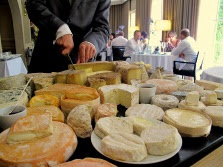1. Less is more. There are many ways to spot a novice but one of the best ways to do so is by the number of cheeses that are chosen. Watch the French---typically they select 3-5 cheeses---any more is considered gluttonous or wasteful as cheese (usually eaten with bread) is very filling.
2. Explore! One of my worst “Ugly American” moments was at a Michelin star restaurant 10 years ago in Burgundy USA
3. Mix or match? Are you a lover of goat cheese like I am? If so, you may want to choose a sampler of just chèvre. One of my faves is any of the chèvre logs covered with black ash, but I’m also wild about Valencay from the Loire Valley (easily identified by its truncated pyramid shape), and Banon from Provence France ) or Reblochon (a soft, rich cow cheese from the Alps ), along with gold medal winning Petit Agour (a semi-hard cheese produced from sheep in the Basque region with nutty profiles). Blue lover? If you know Roquefort (made from sheep), try another of France
4. Communicate. If you’re a beginner let the server know and ask him to select for you. If you have preferences (e.g. cow, goat or sheep), let this be known as well. No, you don’t have to speak French to do so…sign language works, and don’t forget that a smile can work wonders.
5. Watch the Clock. Cheese should be eaten in order from the mildest to strongest. Prior to choosing, ask the server to arrange them in order placing the mildest cheese at the top of the plate (12 position of a clock), ending with the strongest (e.g. blue) at the 9 position on the clock.
Bon appétit...and remember, be adventurous!

No comments:
Post a Comment